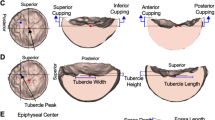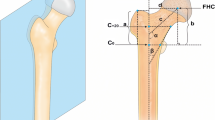Abstract
Developmental dysplasia of the hip (DDH) is a common cause of elevated contact stress and early onset osteoarthritis (OA). We hypothesized that adaptation to focal loading during postnatal development would result in signature changes to the shape of the femoral head secondary center of ossification (SCO). SCO shape was evaluated in a canine model of DDH at ages 14 and 32 weeks. The evolving 3D morphology of the SCO was captured using serial quantitative computed tomography. A discrete medial representation shape model was fit to each SCO and served as the basis for quantitative thickness and bending measurements. Shape measurements were tested for associations with hip subluxation and degeneration. At 32 weeks, the SCO was thinner (flatter) in the perifoveal region, the site of focal loading; a greater bend to the SCO was present lateral to the site of thinning; SCO thinning and bending were associated with less femoral head coverage and with a higher probability of degeneration. Shape changes were not detected at 14 weeks. Measurement and visualization of SCO shape changes due to altered loading may provide a basis for identifying hips at risk of early onset OA and a tool for surgical planning of hip restructuring.










Similar content being viewed by others
References
Babis, G. C., V. I. Sakellariou, M. I. O’Connor, A. D. Hanssen, and F. H. Sim. Proximal femoral allograft-prosthesis composites in revision hip replacement: a 12-year follow-up study. J. Bone Joint Surg. Br. 92:349–355, 2010.
Berry, D. J., W. S. Harmsen, M. E. Cabanela, and B. F. Morrey. Twenty-five-year survivorship of two thousand consecutive primary Charnley total hip replacements: factors affecting survivorship of acetabular and femoral components. J. Bone Joint Surg. Am. 84-A:171–177, 2002.
Buckwalter, J. A., C. Saltzman, and T. Brown. The impact of osteoarthritis: implications for research. Clin. Orthop. Relat. Res. 427(Suppl):S6–S15, 2004.
Burton-Wurster, N., J. P. Farese, R. J. Todhunter, and G. Lust. Site-specific variation in femoral head cartilage composition in dogs at high and low risk for development of osteoarthritis: insights into cartilage degeneration. Osteoarthritis Cartilage 7:486–497, 1999.
Clohisy, J. C., P. E. Beaule, A. O’Malley, M. R. Safran, and P. Schoenecker. AOA symposium. Hip disease in the young adult: current concepts of etiology and surgical treatment. J. Bone Joint Surg. Am. 90:2267–2281, 2008.
Clohisy, J. C., J. C. Carlisle, R. Trousdale, Y. J. Kim, P. E. Beaule, P. Morgan, K. Steger-May, P. L. Schoenecker, and M. Millis. Radiographic evaluation of the hip has limited reliability. Clin. Orthop. Relat. Res. 467:666–675, 2009.
Cunningham, T., R. Jessel, D. Zurakowski, M. B. Millis, and Y. J. Kim. Delayed gadolinium-enhanced magnetic resonance imaging of cartilage to predict early failure of Bernese periacetabular osteotomy for hip dysplasia. J. Bone Joint Surg. Am. 88:1540–1548, 2006.
Fletcher, P. T., C. Lu, S. Pizer, and S. Joshi. Principal geodesic analysis for the study of nonlinear statistics of shape. IEEE Trans. Med. Imaging 23:995–1005, 2004.
Gettys, F. K., J. B. Jackson, and S. L. Frick. Obesity in pediatric orthopaedics. Orthop. Clin. North Am. 42:95–105, 2011.
Gonzalez, R. C., and R. E. Woods. Digital Image Processing. Upper Saddle River: Prentice Hall, p. 793, 2002.
Harrison, T. J. The influence of the femoral head on pelvic growth and acetabular form in the rat. J. Anat. 95:12–24, 1961.
Jacobsen, S., L. Romer, and K. Soballe. The other hip in unilateral hip dysplasia. Clin. Orthop. Relat. Res 446:239–246, 2006.
Jacobsen, S., and S. Sonne-Holm. Hip dysplasia: a significant risk factor for the development of hip osteoarthritis. A cross-sectional survey. Rheumatology 44:211–218, 2005.
Jee, W. S. Integrated bone tissue physiology: anatomy and physiology. In: Bone Mechanics Handbook, edited by S. C. Cowin. Boca Raton: CRC Press LLC, 2001, pp. 1.1–1.68.
Kostis, W. J., A. P. Reeves, D. F. Yankelevitz, and C. I. Henschke. Three-dimensional segmentation and growth-rate estimation of small pulmonary nodules in helical CT images. IEEE Trans. Med. Imaging 22:1259–1274, 2003.
Langenskiold, A., O. Shapiro, and J. E. Michelsson. Experimental dislocation of the hip in the rabbit. J. Anat. 95:12–26, 1962.
Littell, R. C. Analysis of unbalanced mixed model data: a case study comparison of ANOVA versus REML/GLS. J. Agric. Biol. Environ. Stat. 7:472–490, 2003.
Lust, G., R. J. Todhunter, H. N. Erb, N. L. Dykes, A. J. Williams, N. I. Burton-Wurster, and J. P. Farese. Repeatability of dorsolateral subluxation scores in dogs and correlation with macroscopic appearance of hip osteoarthritis. Am. J. Vet. Res. 62:1711–1715, 2001.
Mavcic, B., B. Pompe, V. Antolic, M. Daniel, A. Iglic, and V. Kralj-Iglic. Mathematical estimation of stress distribution in normal and dysplastic human hips. J. Orthop. Res. 20:1025–1030, 2002.
Maxian, T. A., T. D. Brown, and S. L. Weinstein. Chronic stress tolerance levels for human articular cartilage: two nonuniform contact models applied to long-term follow-up of CDH. J. Biomech. 28:159–166, 1995.
McLeod, K. J., C. T. Rubin, M. W. Otter, and Y. X. Qin. Skeletal cell stresses and bone adaptation. Am. J. Med. Sci. 316:176–183, 1998.
Merck, D., G. Tracton, R. Saboo, J. Levy, E. Chaney, S. Pizer, and S. Joshi. Training models of anatomic shape variability. Med. Phys. 35:3584–3596, 2008.
Oegema, T. R., and D. Visco. Animal models of osteoarthritis. In: Animal Models in Orthopaedic Research, edited by Y. H. An, and R. J. Friedman. New York: CRC Press, 1999, pp. 349–367.
Ogden, C. L., M. D. Carroll, L. R. Curtin, M. M. Lamb, and K. M. Flegal. Prevalence of high body mass index in US children and adolescents, 2007–2008. JAMA 303:242–249, 2010.
Pizer, S., D. S. Fritsch, P. A. Yushkevich, and V. Johnson. Segmentation, registration and measurement of shape variability via image object shape. IEEE Trans. Med. Imaging 18:851–865, 1999.
Pizer, S., Q. Han, S. Joshi, P. T. Fletcher, P. Yushkevich, and A. Thall. Synthesis, deformation, and statistics of 3D objects via m-reps. In: Medial Representations Mathematics, Algorithms and Applications, edited by K. Siddiqi, and S. M. Pizer. Heidelberg: Springer, 2008, pp. 241–266.
Pizer, S., K. Siddiqi, and P. Yushkevich. Introduction. In: Medial Representations Mathematics, Algorithms and Applications, edited by K. Siddiqi, and S. M. Pizer. Heidelberg: Springer, 2008, pp. 1–34.
Pizer, S., M. Styner, T. Terriberry, R. Broadhurst, S. Joshi, E. Chaney, and P. T. Fletcher. Statistical applications with deformable m-reps anatomic object segmentation and discrimination. In: Medial Representations Mathematics, Algorithms and Applications, edited by K. Siddiqi, and S. M. Pizer. Heidelberg: Springer, 2008, pp. 269–308.
Raudenbush, S. W., and A. S. Bryk. Hierarchical Linear Models: Applications and Data Analysis Methods. Thousand Oaks: Sage, 485 pp, 2002.
Riser, W. H. The dog as a model for the study of hip dysplasia. Growth, form, and development of the normal and dysplastic hip joint. Vet. Pathol. 12:234–334, 1975.
Russell, M. E., K. H. Shivanna, N. M. Grosland, and D. R. Pedersen. Cartilage contact pressure elevations in dysplastic hips: a chronic overload model. J. Orthop. Surg. 1:6, 2006.
Smith, W. S., R. J. Ireton, and C. R. Coleman. Sequelae of experimental dislocation of a weight-bearing ball- and socket joint in a young growing animal; gross alterations in bone and cartilage. J. Bone Joint Surg. Am. 40-A:1121–1127, 1958.
Vanden Berg-Foels, W. S., S. J. Schwager, R. J. Todhunter, and A. P. Reeves. Femoral head bone mineral density patterns may identify hips at risk of degeneration. Ann. Biomed. Eng. 39:75–84, 2011.
Vanden Berg-Foels, W. S., R. J. Todhunter, S. J. Schwager, and A. P. Reeves. Effect of early postnatal body weight on femoral head ossification onset and hip osteoarthritis in a canine model of developmental dysplasia of the hip. Pediatr. Res. 60:549–554, 2006.
Villemure, I., and I. A. Stokes. Growth plate mechanics and mechanobiology. A survey of present understanding. J. Biomech. 42:1793–1803, 2009.
Weinstein, S. L. Natural history of congenital hip dislocation (CDH) and hip dysplasia. Clin. Orthop. Relat. Res. 225:62–76, 1987.
Acknowledgments
The authors thank Dr. Stephen M. Pizer for providing the Binary Pablo software and Drs. Gregg Tracton and Graham Gash for technical support and much practical advice. This research was supported by the New York State Advanced Technology Biotechnology Program (RJT, WSVBF), Cornell University College of Veterinary Medicine Consolidated Research Grant Program (RJT, WSVBF), NSF and AAUW Graduate Fellowships (WSVBF).
Author information
Authors and Affiliations
Corresponding author
Additional information
Associate Editor Sean S. Kohles oversaw the review of this article.
Rights and permissions
About this article
Cite this article
Vanden Berg-Foels, W.S., Schwager, S.J., Todhunter, R.J. et al. Femoral Head Shape Differences During Development May Identify Hips at Risk of Degeneration. Ann Biomed Eng 39, 2955–2963 (2011). https://doi.org/10.1007/s10439-011-0393-3
Received:
Accepted:
Published:
Issue Date:
DOI: https://doi.org/10.1007/s10439-011-0393-3




